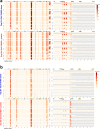Immunogenicity, safety, and efficacy of sequential immunizations with an SIV-based IDLV expressing CH505 Envs
- PMID: 33298954
- PMCID: PMC7674457
- DOI: 10.1038/s41541-020-00252-w
Immunogenicity, safety, and efficacy of sequential immunizations with an SIV-based IDLV expressing CH505 Envs
Abstract
A preventative HIV-1 vaccine is an essential intervention needed to halt the HIV-1 pandemic. Neutralizing antibodies protect against HIV-1 infection in animal models, and thus an approach toward a protective HIV-1 vaccine is to induce broadly cross-reactive neutralizing antibodies (bnAbs). One strategy to achieve this goal is to define envelope (Env) evolution that drives bnAb development in infection and to recreate those events by vaccination. In this study, we report the immunogenicity, safety, and efficacy in rhesus macaques of an SIV-based integrase defective lentiviral vector (IDLV) expressing sequential gp140 Env immunogens derived from the CH505 HIV-1-infected individual who made the CH103 and CH235 bnAb lineages. Immunization with IDLV expressing sequential CH505 Envs induced higher magnitude and more durable binding and neutralizing antibody responses compared to protein or DNA +/- protein immunizations using the same sequential envelopes. Compared to monkeys immunized with a vector expressing Envs alone, those immunized with the combination of IDLV expressing Env and CH505 Env protein demonstrated improved durability of antibody responses at six months after the last immunization as well as lower peak viremia and better virus control following autologous SHIV-CH505 challenge. There was no evidence of vector mobilization or recombination in the immunized and challenged monkeys. Although the tested vaccines failed to induce bnAbs and to mediate significant protection following SHIV-challenge, our results show that IDLV proved safe and successful at inducing higher titer and more durable immune responses compared to other vaccine platforms.
Conflict of interest statement
The authors declare no competing interests.
Figures








References
Grants and funding
- P01 AI110485/AI/NIAID NIH HHS/United States
- 1P01AI110485-01A1/U.S. Department of Health & Human Services | NIH | National Institute of Allergy and Infectious Diseases (NIAID)
- HHSN27201100016C/U.S. Department of Health & Human Services | NIH | National Institute of Allergy and Infectious Diseases (NIAID)
LinkOut - more resources
Full Text Sources

